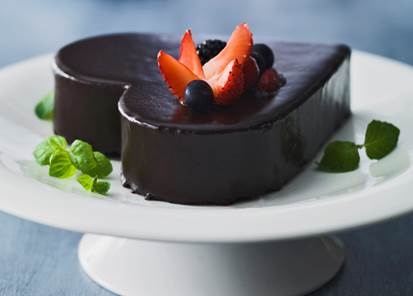How to give your loved one a real Valentine’s Day without the roses

Around the world, February 14 marks a day filled with chocolates, flowers, gifts and most importantly, love. It’s an occasion where special someone’s are showered with affection, and sweet nothings are exchanged all in the name of Saint Valentine. But is Valentine’s Day all about the gifts?
While there are several stories as to how Valentine’s day originated, many believe it started as a Roman festival called Lupercalia, which helped officially mark the start of springtime in February1, and from there developed into an international day of romance.
Today, some argue cupid’s holiday has become over-commercialised with the average Australian spending $127.002 on their partner; however, Le Cordon Bleu’s Master of Gastronomic Tourism and Haute Etudes du Gout graduate Neil Gow explains that through the science of food and dining, we can give our special someone a Valentine’s Day that is worth its weight in truffles without the dollar figures attached to it.
“To create the perfect romantic dinner for your loved one, consider more than just what you’re cooking but also the dining experience as the subconscious, association, suggestion and invoking a sense of nostalgia plays a big role when it comes to how pleasurable dining is,” said Mr Gow.
“The shape and colour of the plate has an impact on how indulgent your loved one will think the food is, the weight of the cutlery indicates a level of luxury, background music impacts ambience and mood and the way the food is presented shows the amount of effort put in to the food itself and even adds to the taste.
“For Valentine’s day the obvious association with red can be very evocative, in the colour of the table cloth, the napkins or obviously red roses, that iconic symbol of love. A subtle reminder of a memory of a previously enjoyed event, displayed discreetly on the table or the inclusion of an evocative aroma.”
Food studies and trends reveal the ambience and aesthetic of the environment accounts for half of a positive dining experience3 and with 72 per cent of people preferring to invest their money into experiences, rather than physical items₄, a scientifically thought out dinner for your loved one may be the way to go.
“When it comes to a Valentine’s Day food experience, throughout history recipes including aphrodisiac ingredients have been curated to inspire passion for diners,” said Mr Gow.
“While the scientific evidence may be lacking on the overall veracity of aphrodisiacs, they often have a smooth and sensual mouthfeel, think chocolate or oysters and that placebo effect can be enough to make your loved ones Valentine’s Day romantic.
“There are scientific studies on the pain and pleasure combination that the body experiences and the bonding feelings that can arise so give some thought to introducing a little unsuspected spicy heat to a dish for an element of surprise and pleasurable endorphin kick.
“I’d suggest starting your experience with Kilpatrick oysters to share alongside a spritz cocktail to balance hot and cold and salty with sparkles. Main could be a medium-rare eye fillet steak with a robust Merlot and to finish I suggest baking the Le Cordon Bleu chocolate heart cake for dessert with strawberries to dress cut into heart shapes, as chocolate contains phenylethylamine, a stimulant that some call a love chemical and is found in high levels when people report they’re in love,” said Mr Gow.
For more Valentine’s Day recipes or to find our more about Le Cordon Bleu and the science of dining courses with Neil Gow, visit https://www.cordonbleu.edu/australia/home/en.
About Le Cordon Bleu:
Le Cordon Bleu was first established in Australia in 1992, when it signed a tripartite agreement with the International College of Hotel Management and TAFE SA to deliver the International Diploma of Hotel Management. In March 1998, Le Cordon Bleu Australia was registered as a company and soon after this, Le Cordon Bleu Australia was sanctioned as a registered training provider.
Today Le Cordon Bleu Australia teaches international standard culinary arts and hospitality management programmes to domestic and international students. With professional, industry trained teaching staff and lecturers, our Australian campuses offer three unique environments to learn the art and mastery of French culinary techniques as well as gastronomy, culture and undergraduate and postgraduate business programmes. Each campus offers a suite of programmes unique to that region, supported by our partner associations and institutions.
1 BBC 2017, What is Valentine's Day and how did it start?, https://www.bbc.co.uk/newsround/16945378
2 News.com.au, 2018, About half of Australians will give Valentine’s Day a miss in 2018, https://www.news.com.au/finance/about-half-of-australians-will-give-valentines-day-a-miss-in-2018/news-story/711648b27ebbefa21568aed04031682a
3Le Cordon Bleu, 2017, How science is changing the dining experience, https://www.cordonbleu.edu/news/how-science-is-changing-the-dining-experience/en
₄Entrepreneur, 2018, 7 Reasons Why Spending Money on Experiences Makes Us Happier Than Buying Stuff, https://www.entrepreneur.com/article/294163
Le Cordon Bleu’s Chocolate Heart
Serves: 8-10
Preparation time: 1 hour 30 minutes
Cook time: 40 minutes
Total time: 3 hours
Ingredients
Chocolate Cake
- 140 g butter
- 225 g dark chocolate, chopped
- 4 egg yolks
- 150 g sugar
- 4 egg whites
- 50 g flour, sifted
Ganache
- 250 g dark chocolate
- 250 ml whipping cream
Decoration
- Raspberries, strawberries, blackberries, blueberries
Method
Preheat the oven to 180ºC (355ºF). Butter and dust with flour a heart-shaped cake tin (or a 24 cm round cake tin).
Chocolate Cake:
Melt the chocolate and the unsalted butter over a bain-marie; stir until smooth. Beat the egg yolks and 75 g of the sugar until they are pale and thick. In a separate bowl, whisk the egg whites, gradually adding the remaining sugar until they are smooth, shiny and stiff peaks form. Fold the sifted flour into the egg yolks-sugar mixture and combine with the melted chocolate-butter mixture. Whisk 1/3 of the egg whites into the chocolate mixture to lighten it; carefully fold in the remainder in two separate batches. Rest the batter for 5 minutes before pouring it into the prepared cake tin. Bake for 40 minutes. Cool on a rack before turning the cake out; refrigerate for 20 minutes.
Ganache:
Coarsely chop the chocolate and place in a bowl. Heat the cream in a small saucepan until simmering and pour over the chocolate; stir until smooth. Set the ganache aside for about 10 minutes at room temperature, until it can be spread easily. When the chocolate cake is cold and fairly hard, cut a thin slice from the top to level it; use a long-serrated knife and cut in a sawing motion. Spread the ganache evenly over the entire surface of the cake; refrigerate for 30 minutes until firm. Decorate with berries.
Note: The cake can be kept refrigerated for 2-3 days. It can also be served with crème anglaise or whipped cream.





